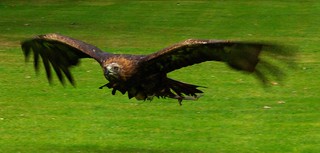This month marks the 25th anniversary of when the first GPS satellite was launched into space at Cape Canaveral. The exact date of that first launch was February 14, 1989, marking the first steps in building a system with capabilities that were incomprehensible at the time. The Global Positioning System is made up of a minimum of 24 satellites orbiting Earth’s atmosphere. Each satellite travels one of six orbital paths 20,000 kilometers (12.4 miles) above us. This way, at any point on the earth’s surface, enough satellites are within range in order to triangulate a location.
Image courtesy of El pak from Wikimedia
Interestingly enough, the very beginnings of the idea for GPS technology began back during the Cold War era space race. The Russians were the first to successfully launch a satellite into orbit in 1957. The satellite was called Sputnik and emitted a regular beeping signal, which could be detected with radio receivers on the ground as it passed overhead. While much of the U.S. were in a paranoid panic about Russian spy technology, two scientists from the Applied Physics Laboratory discovered a way to measure the exact location of the satellite based on the transmission.
Much like how a fire truck siren sounds louder as it’s approaching and quieter once it’s passed, Sputnik’s transmission would get compressed and shorten as it approached and the wavelengths lengthened as it passed. This phenomenon is also known as the Doppler effect. The scientists were able to figure out Sputnik’s orbit using one of the first U.S. commercial computers. Not long after, the team was asked if they could determine a person’s location on Earth, based on where the satellite was in its orbit. Working with DARPA (the Department of Defense’s Advanced Research Projects Agency), also responsible for developing the Internet, they began launching their own satellites in 1964 as part of the U.S.’s first satellite navigation system, called TRANSIT, which was primarily used by the Navy missile submarines.
Essentially, most of the first satellite navigation systems were developed in order to improve the accuracy of missile launches. During the Cold War, the U.S. military was invested in being able to launch nuclear missiles from anywhere they could. Because the TRANSIT program was working well, in the 1960s, the U.S. Air Force launched their own satellite navigation system, called MOSAIC. The Army soon followed with their SECOR program, which used satellites to find the location of a unit on Earth. Around 1973, the military realized they could combine all three satellite navigation systems to create something much more sophisticated.
They came up with a program called Navstar-GPS (Navigation System Using Timing and Ranging Program – Global Positioning System), which was eventually shortened to GPS. The military launched 11 more navigation satellites into space between 1978 and 1985, although only ten of them were functional. In 1983 a Korean Air Lines flight was shot down after it drifted into forbidden U.S.S.R. territory. President Reagan responded with a promise to make GPS technology available for passenger aircrafts in order to prevent future tragedies. The first GPS satellite available for commercial use was launched in 1989. The launch was originally planned for 1986, but the devastating Challenger launch failure delayed the schedule.
![]() The modern GPS constellation was completed in 1994, and there are currently 32 orbiting satellites in our atmosphere in order to guarantee accuracy in the readings. The Russian government have also developed a similar navigation system, called GLONASS, which is currently in orbit. China is also developing a satellite navigation system, called Beidou. Galileo is another navigation system being developed by the European Union. It seems that Earth’s atmosphere is getting a bit crowded with satellites.
The modern GPS constellation was completed in 1994, and there are currently 32 orbiting satellites in our atmosphere in order to guarantee accuracy in the readings. The Russian government have also developed a similar navigation system, called GLONASS, which is currently in orbit. China is also developing a satellite navigation system, called Beidou. Galileo is another navigation system being developed by the European Union. It seems that Earth’s atmosphere is getting a bit crowded with satellites.
When GPS was first made available to civilians, there was a lot of paranoia that the technology would be used against the U.S.. In order to prevent this, the version of GPS that was made available to civilians was only accurate within 100 meters (109.4 yards). President Clinton changed this policy in 2000 so that civilian GPS devices are now accurate within 5 to 10 meters (5.5 to 10.9 yards). Since then, as the technology has become more versatile and affordable, we’ve seen GPS become part of every day life in the United States.
The technology was first majorly adopted by the public when GPS navigation systems started popping up on the market with turn-by-turn directions. With the Internet, people had gotten used to plugging in their starting point and destination and receiving detailed directions. These navigation devices took that to a new level by installing the map right into the vehicle. Then smartphone GPS capabilities put this technology in the hands of the masses.
GPS technology has been used for so much over the last 25 years. We use it to play games, exercise, explore, protect ourselves and our loved ones, and even save lives. What is your favorite function of GPS technology? Let us know in the comments!
GPS Celebrates 25 Years In Space


